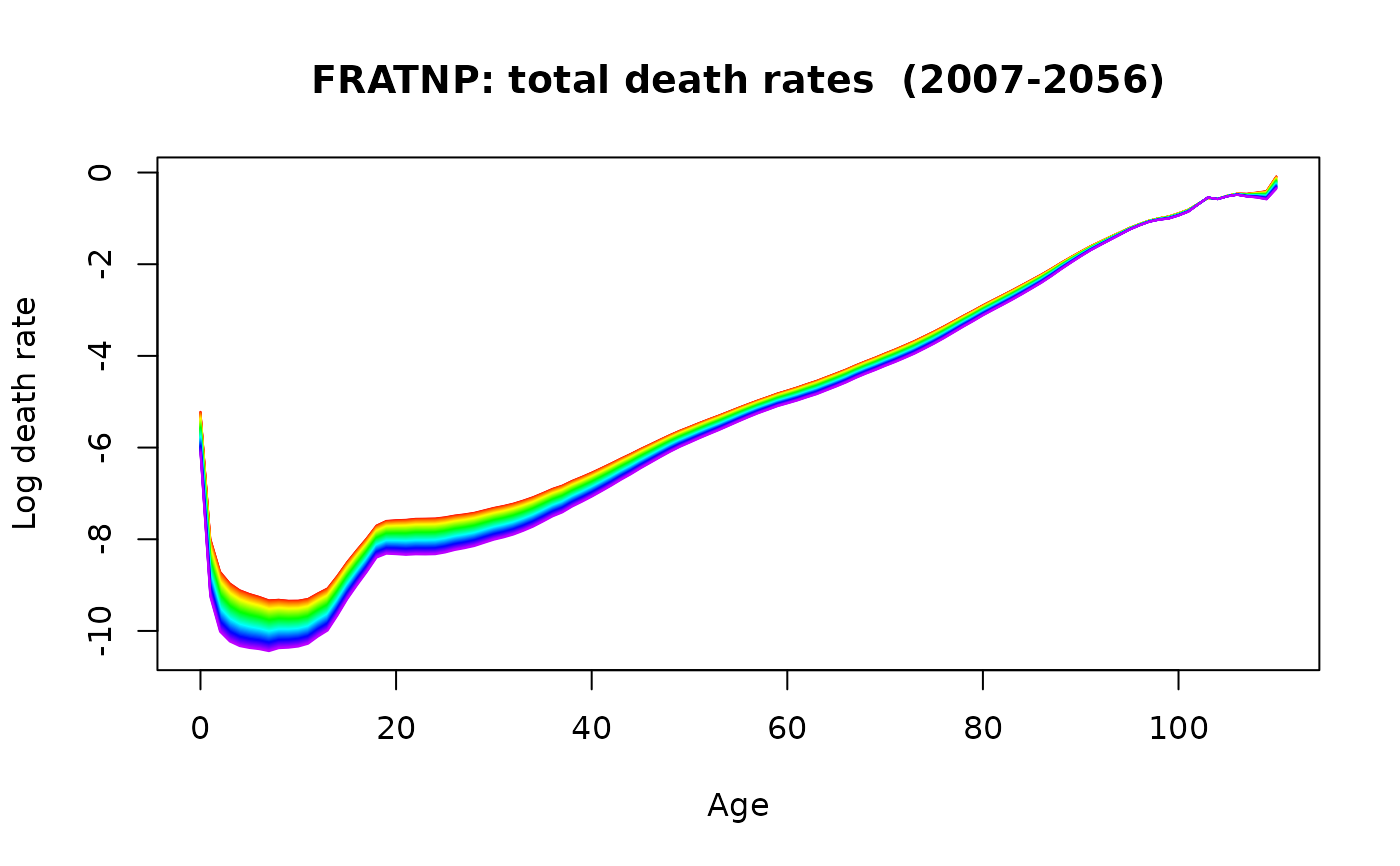The coefficients from the fitted object are forecast using a univariate time series model. The forecast coefficients are then multiplied by the basis functions to obtain a forecast demographic rate curve.
Usage
# S3 method for class 'fdm'
forecast(
object,
h = 50,
level = 80,
jumpchoice = c("fit", "actual"),
method = "arima",
warnings = FALSE,
...
)Arguments
- object
Output from
fdm.- h
Forecast horizon.
- level
Confidence level for prediction intervals.
- jumpchoice
If "actual", the forecasts are bias-adjusted by the difference between the fit and the last year of observed data. Otherwise, no adjustment is used.
- method
Forecasting method to be used.
- warnings
If TRUE, warnings arising from the forecast models for coefficients will be shown. Most of these can be ignored, so the default is
warnings=FALSE.- ...
Other arguments as for
forecast.ftsm.
Value
Object of class fmforecast with the following components:
- label
Name of region from which the data are taken.
- age
Ages from
lcaoutobject.- year
Years from
lcaoutobject.- rate
List of matrices containing forecasts, lower bound and upper bound of prediction intervals. Point forecast matrix takes the same name as the series that has been forecast.
- error
Matrix of one-step errors for historical data
- fitted
Matrix of one-step forecasts for historical data
- coeff
List of objects of type
forecastcontaining the coefficients and their forecasts.- coeff.error
One-step errors for each of the coefficients.
- var
List containing the various components of variance: model, error, mean, total and coeff.
- model
Fitted model in
obj.- type
Type of data: “mortality”, “fertility” or “migration”.
Examples
france.fit <- fdm(fr.mort, order = 2)
france.fcast <- forecast(france.fit, 50)
plot(france.fcast)
 models(france.fcast)
#>
#> -- Coefficient 1 --
#> Series: xx[, i]
#> ARIMA(1,1,1) with drift
#>
#> Coefficients:
#> ar1 ma1 drift
#> 0.6383 -0.8145 -0.1265
#> s.e. 0.1481 0.1120 0.0411
#>
#> sigma^2 = 1.206: log likelihood = -285.97
#> AIC=579.95 AICc=580.16 BIC=592.93
#>
#> -- Coefficient 2 --
#> Series: xx[, i]
#> ARIMA(2,1,1)
#>
#> Coefficients:
#> ar1 ar2 ma1
#> 0.3818 0.2926 -0.9679
#> s.e. 0.0758 0.0745 0.0280
#>
#> sigma^2 = 0.9067: log likelihood = -259.4
#> AIC=526.79 AICc=527.01 BIC=539.78
models(france.fcast)
#>
#> -- Coefficient 1 --
#> Series: xx[, i]
#> ARIMA(1,1,1) with drift
#>
#> Coefficients:
#> ar1 ma1 drift
#> 0.6383 -0.8145 -0.1265
#> s.e. 0.1481 0.1120 0.0411
#>
#> sigma^2 = 1.206: log likelihood = -285.97
#> AIC=579.95 AICc=580.16 BIC=592.93
#>
#> -- Coefficient 2 --
#> Series: xx[, i]
#> ARIMA(2,1,1)
#>
#> Coefficients:
#> ar1 ar2 ma1
#> 0.3818 0.2926 -0.9679
#> s.e. 0.0758 0.0745 0.0280
#>
#> sigma^2 = 0.9067: log likelihood = -259.4
#> AIC=526.79 AICc=527.01 BIC=539.78